#moral of the story is don’t go to a hairdresser who claims to know how to cut wavy/curly hair but actually LIED
Link
When Rokhaia Naassan gives birth in the coming days, she and her baby boy will enter a new category in the eyes of Danish law. Because she lives in a low-income immigrant neighborhood described by the government as a “ghetto,” Rokhaia will be what the Danish newspapers call a “ghetto parent” and he will be a “ghetto child.”
Starting at the age of 1, “ghetto children” must be separated from their families for at least 25 hours a week, not including nap time, for mandatory instruction in “Danish values,” including the traditions of Christmas and Easter, and Danish language. Noncompliance could result in a stoppage of welfare payments. Other Danish citizens are free to choose whether to enroll children in preschool up to the age of six.
Denmark’s government is introducing a new set of laws to regulate life in 25 low-income and heavily Muslim enclaves, saying that if families there do not willingly merge into the country’s mainstream, they should be compelled.
For decades, integrating immigrants has posed a thorny challenge to the Danish model, intended to serve a small, homogeneous population. Leaders are focusing their ire on urban neighborhoods where immigrants, some of them placed there by the government, live in dense concentrations with high rates of unemployment and gang violence.
Politicians’ description of the ghettos has become increasingly sinister. In his annual New Year’s speech, Prime Minister Lars Lokke Rasmussen warned that ghettos could “reach out their tentacles onto the streets” by spreading violence, and that because of ghettos, “cracks have appeared on the map of Denmark.” Politicians who once used the word “integration” now call frankly for “assimilation.”
That tough approach is embodied in the “ghetto package.” Of 22 proposals presented by the government in early March, most have been agreed upon by a parliamentary majority, and more will be subject to a vote in the fall.
Some are punitive: One measure under consideration would allow courts to double the punishment for certain crimes if they are committed in one of the 25 neighborhoods classified as ghettos, based on residents’ income, employment status, education levels, number of criminal convictions and “non-Western background.” Another would impose a four-year prison sentence on immigrant parents who force their children to make extended visits to their country of origin — described here as “re-education trips” —in that way damaging their “schooling, language and well-being.” Another would allow local authorities to increase their monitoring and surveillance of “ghetto” families.
Some proposals have been rejected as too radical, like one from the far-right Danish People’s Party that would confine “ghetto children” to their homes after 8 p.m. (Challenged on how this would be enforced, Martin Henriksen, the chairman of Parliament’s integration committee, suggested in earnest that young people in these areas could be fitted with electronic ankle bracelets.)
At this summer’s Folkemodet, an annual political gathering on the island of Bornholm, the justice minister, Soren Pape Poulsen, shrugged off the rights-based objection.
“Some will wail and say, ‘We’re not equal before the law in this country,’ and ‘Certain groups are punished harder,’ but that’s nonsense,” he said, adding that the increased penalties would affect only people who break the law.
To those claiming the measures single out Muslims, he said: “That’s nonsense and rubbish. To me this is about, no matter who lives in these areas and who they believe in, they have to profess to the values required to have a good life in Denmark.”
Yildiz Akdogan, a Social Democrat whose parliamentary constituency includes Tingbjerg, which is classified as a ghetto, said Danes had become so desensitized to harsh rhetoric about immigrants that they no longer register the negative connotation of the word “ghetto” and its echoes of Nazi Germany’s separation of Jews.
“We call them ‘ghetto children, ghetto parents,’ it’s so crazy,” Ms. Akdogan said. “It is becoming a mainstream word, which is so dangerous. People who know a little about history, our European not-so-nice period, we know what the word ‘ghetto’ is associated with.”
She pulled out her phone to display a Facebook post from a right-wing politician, railing furiously at a Danish supermarket for selling a cake reading “Eid Mubarak,” for the Muslim holiday of Eid. “Right now, facts don’t matter so much, it’s only feelings,” she said. “This is the dangerous part of it.”
For their part, many residents of Danish “ghettos” say they would move if they could afford to live elsewhere. On a recent afternoon, Ms. Naassan was sitting with her four sisters in Mjolnerparken, a four-story, red brick housing complex that is, by the numbers, one of Denmark’s worst ghettos: forty-three percent of its residents are unemployed, 82 percent come from “non-Western backgrounds,” 53 percent have scant education and 51 percent have relatively low earnings.
The Naassan sisters wondered aloud why they were subject to these new measures. The children of Lebanese refugees, they speak Danish without an accent and converse with their children in Danish; their children, they complain, speak so little Arabic that they can barely communicate with their grandparents. Years ago, growing up in Jutland, in Denmark’s west, they rarely encountered any anti-Muslim feeling, said Sara, 32.
“Maybe this is what they always thought, and now it’s out in the open,” she said. “Danish politics is just about Muslims now. They want us to get more assimilated or get out. I don’t know when they will be satisfied with us.”
Rokhaia, her due date fast approaching, flared with anger at the mandatory preschool program approved by the government last month: Already, she said, her daughter was being taught so much about Christmas in kindergarten that she came home begging for presents from Santa Claus.
“Nobody should tell me whether or how my daughter should go to preschool. Or when,” she said. “I’d rather lose my benefits than submit to force.”
Barwaqo Jama Hussein, 18, a Somali refugee, noted that many immigrant families, including her own, had been settled in “ghetto” neighborhoods by the government. She moved to Denmark when she was 5 and has lived in the Tingbjerg ghetto area since she was 13. She said the politicians’ description of “parallel societies” simply did not fit her, or Tingbjerg.
“It hurts that they don’t see us as equal people,” she said. “We actually live in Danish society. We follow the rules, we go to school. The only thing we don’t do is eat pork.”
About 12 miles south of the city, in the middle-class suburb of Greve, though, voters gushed with approval over the new laws.
“They spend too much Danish money,” said Dorthe Pedersen, a hairdresser, daubing chestnut dye on a client’s hairline. “We pay their rent, their clothing, their food, and then they come in broken Danish and say, ‘We can’t work because we’ve got a pain.’”
Her client, Anni Larsen, told a story about being invited by a Turkish immigrant to their child’s wedding and being scandalized to discover that the guests were separated by gender and seated in different rooms. “I think there were only 10 people from Denmark,” she said, appalled. “If you ask me, I think they shouldn’t have invited us.”
Anette Jacobsen, 64, a retired pharmacist’s assistant, said she so treasured Denmark’s welfare system, which had provided her four children with free education and health care, that she felt a surge of gratitude every time she paid her taxes, more than 50 percent of her yearly income. As for immigrants using the system, she said, “There is always a cat door for someone to sneak in.”
“Morally, they should be grateful to be allowed into our system, which was built over generations,” she said.
676 notes
·
View notes
Text
Pink Power Rankings (Pt. 2)
youtube
This is our next segment of “Pink Power Rankings”, I hope to do a few more in the future, including ones centered on the American Girl dolls and the Disney Princesses. The video above is the famous “Think Pink!” musical number from Funny Girl, so without further ado, time to rank these pink moments!
The Gorgeous Ladies Of Wrestling

This is a show where wrestlers do their thing on a ring bordered by pink ropes, so of course pink is going to come up....a lot. Even when it comes to donuts and abortion ( “I like pink things” “Well if you liked pink things less, you wouldn’t be in this situation”). The show centers on a team of diverse women wrestlers and their manager (Sam Sylvia, played by a hilarious Marc Maron) and producer (closeted Bash Howard, played by the appropriately 80′s Ken lookalike Chris Lowell): struggling actress Ruth (by a charming Alison Brie), former soap opera star and housewife turned wrestler and co-producer Debbie (the talented Betty Gilpin), stuntwoman and coach Cherry (a beautiful turn by Sydelle Noel) and her stunt-double husband Keith (utterly likable Bashir Salahuddin), daughter and sister of wrestlers Carmen (a winsome Britney Young), cheerful Brit Rhonda (the multi-faceted Kate Nash), wolfgirl Sheila (a dry Gayle Rankin), the humorous single mom Tammé (former wrestler Kia Stevens showing off brilliant emotional chops), the outrageous religious Jew Melrose (Fran Drescher lookalike Jackie Tohn), hairdressing kayfabe duo Stacy & Dawn (Kimmy Gatewood and Rebekka Johnson), Indian American bisexual med student Arthie (Sunita Mani a.k.a. the Turn Down For What girl), Olympian and taciturn Reggie (an athletic Marianna Palka), Valley Girl seamstress and former refugee Jenny (the eye-catching Ellen Wong), and the extroverted stripper and breakdancer lesbian Yolanda (a triple-threat Shakira Barerra).
In the Season 2 finale of the show (and as a bid to keep the undocumented Rhonda in the United States) they stage a wedding ceremony for Rhonda where the rest of the wrestlers are wearing pink and gold leotards with ruffled sleeves (how 80s is that), which they integrate into their Vegas show in Season 3. In the first episode of the season, several things go wrong: Debbie and Ruth (in their wrestling roles Liberty Belle and the Soviet Zoya the Destroyer) comment in the local news on the Challenger spaceship launch where the rocket explodes in the air while Ruth is absorbed in her role as the heel, a fire alarm goes off at the casino during dress rehearsal which Jenny blames on her lighting incense to cleanse the atmosphere for the show (turns out to be false to distract from the doldrums of the tragedy), and the girls play on the tables and later have a successful show. A huge up in a show about the ups and downs of show business.
Power Ranking: 8.
The Plastics
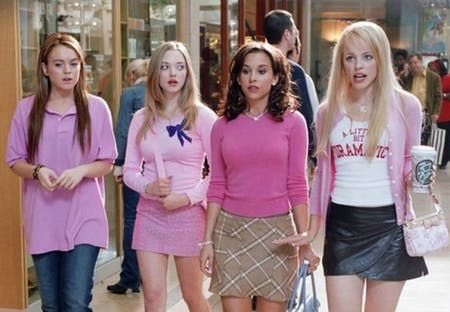
“On Wednesdays we wear pink.”
One of the many rules to abide by if you are in North Shore High’s exclusive popular clique, The Plastics. Cady has been homeschooled abroad since she was a child and is transplanted to a surburban high school where it looks like dealing with social dynamics is going to be a lot tougher than knowing what to do if you encounter a lion out in the wilderness. Led by the ruthless and manipulative Regina George, the clique is formed up of girls who are the most privileged and prettiest in the high school (and when you look at it Regina is co-opting the power that comes with being the daughter of the founder of Toaster Strudel or being really pretty) and they keep a Burn Book of all their girl classmates (and one gay guy) where they write insulting things about them. They are quick to punish by calling your mom on the phone and telling her you got some urgent results from Planned Parenthood or by laying claim to your ex-boyfriend. But the leader Regina is a unhappy girl whose mother is more interested in pleasing her than nurturing her and she feels she cannot apply herself to intellectual activities because it’s “uncool” and that she has to be underweight to be the pinnacle of beauty, she belittles the self-worth of her most loyal friends for their intelligence or their popularity and views Cady as competition. Also as Regina learns, the student body is actually afraid of her and they are willing to laugh at her when given the chance.
Power Ranking: 4.
Andie Walsh

I would be remiss not to include the main character of the film titled: Pretty In Pink. Our character is very smart, going places, hard-working, and a fashionista with her signature color (despite the hideous prom dress) and she has been disappointed in love by her richie boyfriend (and being hit on by his sleazebag friend and her childhood friend) and despite the prom look here, she has killer fashion sense. It’s a shame she cut up her maternal figure of a friend’s old 60s (cute) prom dress and another party dress to create this monstrosity.
But she hits this prom to prove to the rich snobs at her school that they haven’t hurt her. And that is power.
Power Ranking: 9.5 (0.5 taken off for hideous prom dress!)
The Pink Ladies
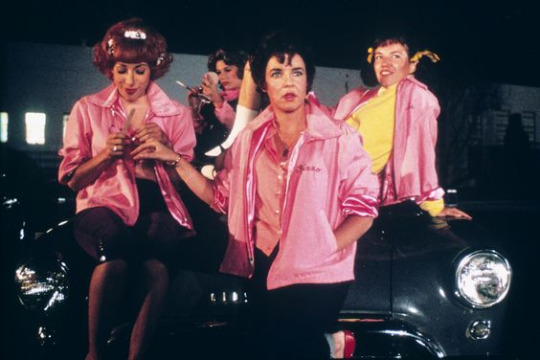
The ultimate Pink clad clique, their pledge is to act cool and to be cool, til death do them part they think pink! They are the all female counterparts to the male T-Birds (the Burger Palace Boys in the original, edgier, musical) and they are interested in subverting the 1950s script for young women...to an extent, to be fair they don’t have a language for subverting respectability but it’s clear often they are mostly dates for the T-Birds. The girls actually do things that were considered shocking for mature women in 1959: they make out and have sex, it’s implied Rizzo gets an abortion (or it was a false positive), they wear pants and shorts, they indulge in the same vices as the boys, they have (gender-appropriate) ambition, multiple romantic partners, talk back to any boys bugging them or remarking on them, pierce their ears (no really women mostly had clip on earrings back then), and they wear clothes for comfort and even clothes that showcase their sex appeal.
But one of them gives Sandy the now problematic behavior, it would have been more subversive if Sandy was encouraged to forget about Danny (which I think she did). But it was the late 1950s and it was hard for a female rebel.
Power Ranking: 8.5.
Taina Morales
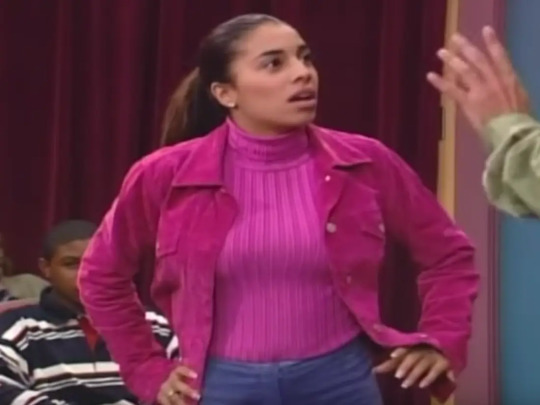
The criminally underrated (and short-lived) sitcom Taina centers on a Nuyorican teenager and her family as she attends a performing arts high school as she works her way to becoming a singer and actress. Fushia, not plain pink, was Taina’s color and the color she picks for her Quincenera dress instead of the garish pastel pink ballgown her mother wants her to wear (as tradition). The episode covers the conflict regarding young Latinas and the pull between what mainstream American culture demands (consumerism and individualism by any means necessary) and the culture of their family’s homeland (which is more collective and built on hierarchy and just as shitty for women as individualist “Me first” culture). I want to say this to my non-Latina and non-Latinix readers: me and my sisters are dealing with a lot, we have demands from relatives who only see our age and youth and not the capable people we already are who have us flipping tortillas at 5 or watching younger siblings after school instead of a after-school job or extracurriculars or even hang out with friends and a mainstream culture that demands we all assimilate and be “real Americans”, try to be understanding and supportive.
It’s difficult but you have to set boundaries and assert your vision....lest you be a horror story from Say Yes to the Dress (Atlanta and Bridesmaids).
Power Ranking: 10 (some folks have no idea).
Deb Bradshaw
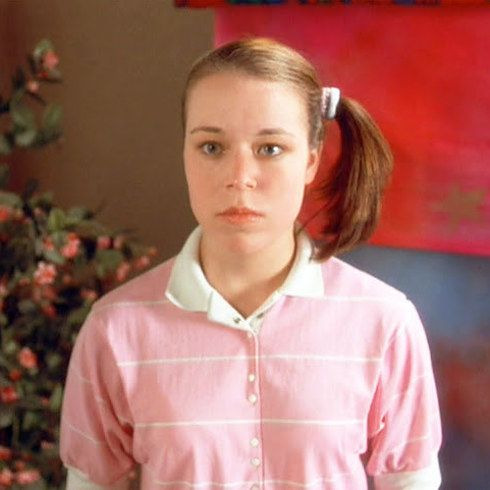
This is Deb Bradshaw, a resident of Idaho where fashion and tech-wise, everyone is stuck in the 1980s and 1990s and it was the mid-2000s. She sells handicrafts and takes glamour photos to raise funds for college and she hangs out with a couple of teenage boys who are quiet (Rico) or awkward (Napoleon) as she. Right now Napoleon’s sleazy Uncle Rico gives her a ad for breast enhancement supplements on the ruse that Napoleon recommended them for her. What does she do? Cry?
Nope. She calls Napoleon and tells him off for supposedly dissing her appearance, tells him she is content with her figure and he can take those supplements himself. In a time that was pushing girls to be sexy and hot and fun and extroverted to impress guys and where fashion was designed to show off impossibly slim, toned, and busty figures with long legs, it was something special.
Power Ranking: 9.8
Little Jordan Sanders

Once up on a time (the early 1990s) there was a nerdy little girl who felt she wowed her fickle classmates and then a mean girl pulled a prank on her that landed her in to the hospital, from there she vowed she will do the bullying before anyone else bullies her.
So she becomes a nightmare boss whose employees can’t stand her (to the point where they are listening to relaxation tapes saying “So you want to slap your boss”) and she forbids carbs in her workplace as she doesn’t eat them. She gets confronted by a little girl with a magic wand who puts a spell on her that doesn’t seem to take but then Jordan wakes up in her preteen body again and has to attend middle school all over again where she gets bullied.
So what does Jordan do? She arms herself with a huge Birkin bag and a pink power suit with a white plaid pattern and makes her way to school and manages to corrupt her new tween friends with her cynical world view. But at some point she embraces her inner geek girl and wakes up an adult woman again.
Power Ranking: 7, it’s a front but a fabulous front.
Midge Maisel
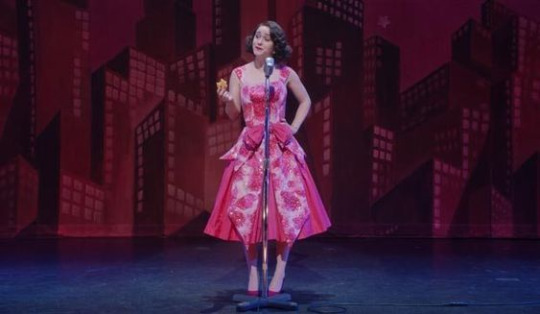
This is the night that Midge would have been made for life....and the night where she burns a bridge with a friend and puts her’s and her manager Susie’s future in jeopardy.
So after starting a career in stand up after her husband leaves her for his mediocre secretary, Midge gets to perform stand up at the famous Apollo theater before pop singer Shy Baldwin’s concert (part of his cross-country tour), this is the community he grew up in and where the local middle-aged mothers bake him goodies so he’d be persuaded to date their daughters. But Midge, a privileged Jewish American woman, is a fish out of water amongst the mostly African American audience and performers.
So she starts to make jokes about Shy’s stage persona and hints at him being a closeted gay man which all bring down the house and impress the audience (and keep the Wop Wop Man at bay)....but then Shy’s manager reveals they have kicked her out from the tour for what she has done. For once the fabulous but thoughtless Midge has faced the consequences of her actions.
Power Ranking: 10, she made an impact alright.
Meg Griffin

By far more the least empowered woman on this list or the list before (even more than Barb who got killed by a monster), Meg Griffin started Family Guy as a ordinary teenage girl who wasn’t popular at school but was assured of love from her then-loving, but dysfunctional and nutty family. Then after a brief cancellation and protests brought the show back, the show and even her family (along with the whole community) started bashing her and calling her “ugly” or dissing her for her weight to the point where the show was being (rightfully) accused of misogyny. Meg so far has had her father fart in her face, her mother try to seduce her boyfriend and leave her pills to potentially OD on, her obese brother gets popular and doesn’t invite her to his party because she doesn’t fit a narrow “boob to butt ratio” (seems like Family Guy hates body fat on women unless it’s on their boobs), her baby brother loves to feed off her tears and to her face told her to become bulimic, and her family dog tells her that God doesn’t exist because she has a shitty family (complete with a Mom he lusts after) and she has “a flat chest and a fat ass”.
Also this “pink condom hat” wearing teen is dished crap by the writers because they claim not to have knowledge of writing teenage girls, gee what could be an improvement on that problem?
Is it any wonder that this girl may have violent episodes?
Power Ranking: 1 (most of the time).
Quinn Morgendorffer

From day one pink has been a color that Quinn wore and while she updated her late 90s baby tee look with deeper colors and modest cuts, pink has remained a primary color. Actually pink has been her preferred color since childhood, her color for school dances, for camping trips, what she wears as a Mommy/Beauty vlogger, the color for the background Jane uses for her abstract portrait of Quinn,
Quinn’s motivation is to be the most attractive and popular girl around, likely stemming from her father’s trait of needing people to pay attention to him, and coincidentally pink is what helps her fit in with her parents and helps her stand out from the Fashion Club, and it helps her align with the late 1990s standard of beauty and femininity (also somewhat aided by her grandmother) that prizes long, shiny, bouncy hair and a teeny weeny nose with microscopic pores, and a fat free (except for the boobs) body over intelligence and substance. This serves to set her apart from her sister Daria, who decides to go against the role. Which is sad because Quinn is very witty and savvy with a gift for fashion analysis and the sisters show a propensity for getting along much better than their mother did with her sisters.
Later in the series, she starts maturing and leans more into her intellectual gifts, thus her jeans and shirt get deeper in color and flaunt her slender mid-section less (they still show the outline of her silhouette). She starts pulling away from her shallow clique and deals with a new friend with alcoholism (not much of a resolution at the end), thankfully somewhat like her sister, she can provide kinship over (cheeseless) pizza and diet soda.
Power Ranking: 10, Family Guy writers take notes.
Daria Morgendorffer

Pink is the color of mortification for Daria. She is the only member of her family to not have a pinkish or reddish tone in her coloring (unless you count her traditional orange shirt under her green blazer and black skirt, something that calls to her mother’s power suit) and femininity seems forced on her. In fact the only time pink was used as a power move was when she used it to convince her sister to stop being a pseudo-intellectual by dressing up like her.
In this image from the tie-in book The Daria Diaries, we see that a younger Daria is dressed up in a high-necked and puff-sleeved nightmare of a pin dress that looks so infantile, that likely Helen forced on her (Quinn would never pick that, no matter how mad Quinn is she would never make someone wear something if she didn’t think it was flattering), and while her mother and sister are in yellow-toned frills that closely matched their tastes, Daria stands apart glum and wishing someone would save her from this fashion emergency.
Power Ranking: 4, just loose the collar at least?
Glinda the Good Witch of the North

The Good (but slightly bitchy) Witch of the North is the representative for how powerful pink can be in 1939 (or rather any time because Oz operates outside our world). She is the guardian (was she battling the Wicked Witches of the East and West for supremacy while the Munchkins were terrorized? Gosh a lot of WWII allegories here) of Oz played by the closeted Bisexual and hilarious Billie Burke, she is good but not above encouraging munchkins to sing about how happy they are that the wicked witch is dead. While munchkins run around scared when the Wicket Witch of the West shows up to corner Dorothy and get the ruby slippers back, Glinda cooly plans on snatching the slippers and poofing them on Dorothy’s feet and drops shade on the Witch.
But Glinda is one to remind the characters (and the audience) that they needed to discover the power within them to achieve their goals and come out the other end stronger, no one can make you believe that.
Power Ranking: 10, this look is so iconic.
Kim McAfee
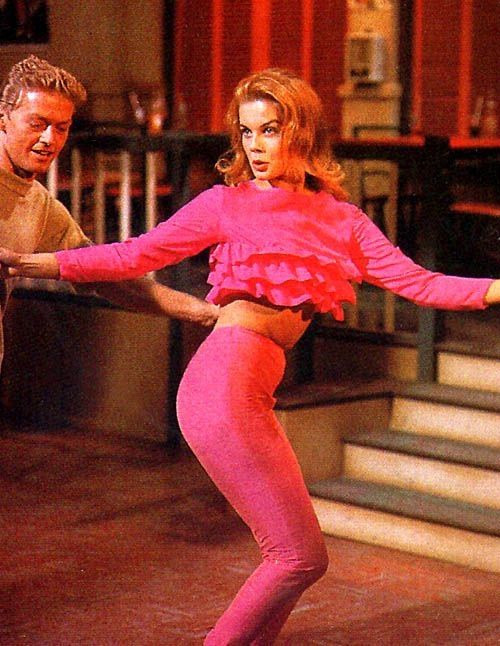
Truly an iconic pink look and not bad for a role where Ann-Margret makes her big break. The teenage Kim MacAfee, member of the Conrad Birdie fan club, gets pinned and is chosen to kiss Conrad during his farewell concert before he leaves for the army. Quite the glow up! But she has to deal with a jealous boyfriend who doesn’t want Conrad around (probably because he can’t make her scream and faint) and her feelings of “I don’t need him but I really want him with me”. This outfit was stunning and meant to convey a lot in 1963: it’s pants, it’s Schiaparelli Pink rather than a dainty pastel like she wears here, it shows off her figure, she sings about kissing men from Yale to Purdue while Conrad and her boyfriend Hugo sing about hot chicks and they all sing about having a lot of living to do. Of course Hugo leaves and she is distraught, up to the point where she kisses Conrad Birdie and Hugo sucker punches him in front of a live audience. She happily ends up with Hugo and wishes Birdie well, as opposed to when she is devastated over him heading to the army (is it no accident the sexists from Mad Men like the first version?).
Power Ranking: 9.5, truly iconic and the outfit to wear when you attempt to be a sexually liberated woman who doesn’t need a possessive man.
Caroline Brooks

Speaking of big breaks, this is the film where Esther Williams (the codifier for swimming musicals and synchronized swimming) makes her big break in a iconic career and it was quite an impressive entrance. And then starts a decade-long career of water ballet musicals and swimwear, the film isn’t remarkable for it’s plot (enjoyable rom-com) but for the impressive swimming sequences that show off Esther’s athletic skills (she was eligible for the 1940 Olympics). That is a way to make an impact with pink.
Power Ranking: 20.
Courtney Gripling

Who’s the girl in the pink capris?
It’s Courtney, it’s Courtney!
This song was sung two times in the show and it tells you a lot about the inner workings of a sweet but sheltered and often insensitive Middle School Queen (for measure, she sings this in a sparkly dress at a friend’s 13th birthday party, friend doesn’t mind though). Courtney would definitely be the kind of girl who’d wear white to a (Western) wedding.
Pink (or peach or lavender or blue or cream) has been a signature color for Courney since the very beginning: it was the color of her pajamas, she told Ginger she looks really good in the color when she borrows sleepwear from the girl, she wore “Popular In Peach” nail polish for her exams the semester before, and she even wore the color of skirt and blouse she wore when she got bullied in high school and learned her family was losing their McMansion and their money (even her port-a-potty was pink with baroque gild). It highlights her delicate and privileged background, like lace or fine china, it will get spoiled.
So this girl, who got by with people being hired to do her homework and sung about herself at another person’s birthday party and had a talent show performance where she and her friends wore blonde wigs and matching costumes (with face masks of herself), the girl who was shocked to find out summer camps don’t have masseuses, the girl who wore platform sandals in the winter, or that Mom losing her platinum card is not the catastrophe she thinks it is.....suddenly finds her family in poverty after her father was caught doing white collar crime.
So sad, she was always better than Ivanka.
Power Ranking: 6.5, glorious look and character but not likely to be invited to anybody’s wedding in the future.
Cher Horowitz

It’s fitting the premier teen fashionista of Beverly Hills undergoes her enlightenment and makes up with her friend in a matching pink preppy ensemble. Cher Horowitz (despite clearly taking some lead from her BFF Dionne’s more sophisticated and colorful take on Bev Hills fashion) has been a trendsetter in-universe and at the time the film came out.
Before the film came out, fashion was inspired by grunge or still stuck in the late 1980s or dominated by neon colors and power dressing and or mixing and matching, then the costume designer for the film (Mona May) decided on taking a twist on the preppy look, while keeping some sportiness and the colors of the time (even nodding to Beverly Hills 90210). May subtly updated looks that Sally Draper and Nancy Wheeler would have worn and for the rest of the decade teen girls were sporting mary janes, plaid, collars, floaty dresses, pastels, stripes, and knee socks.
At the start of the film, Cher thinks she knows it all and she is the most popular girl in her school....she doesn’t really know it all (she’s Clueless). She does aspire to be more and do more (and sometimes plagued by insecurity) and takes new grunge girl Tai under her wing and gives her a makeover that makes her look like a shorter, redhaired, and curvier clone of Cher herself until Tai gets swollen in the head and Cher realizes she loves her ex-stepbrother Josh. After an argument, a humbled Tai (in a style that combines the preppy femininity she learned in Beverly Hills and her skater geek inclinations that manages to hold well into the mid 2000s) makes up with her and they watch Tai’s love interest shred out.
Here we see Cher in her feminine prep but the casual look and the prints help her empathize with the crowd on the grass.
Power Ranking: 9.
Miss Piggy

Beauty is in the eye of the beholder, and it may be necessary from time to time to give a stupid or misinformed beholder a black eye.
The ultimate diva in pink, with all her charms, cannot attract Kermit the Frog and the woman who assured at least one generation of girls that they don’t need to be slender princesses to be the leading lady. Before Elle Woods, Miss Piggy came in with blown out wings and curls and in pink outfits assured of her own place in show business and of her own beauty and especially during an era when society was learning (slowly) to accept other forms of female personality and challenging gender roles. She was a revolutionary clad in the style of women of the Golden Age of Hollywood and made a mark for more body inclusivity in entertainment and transcended the girly girl/tomboy dichotomy that had been around to enforce stereo-typically feminine behavior and set up women to compete against one another.
Power Ranking: 10.
Blossom
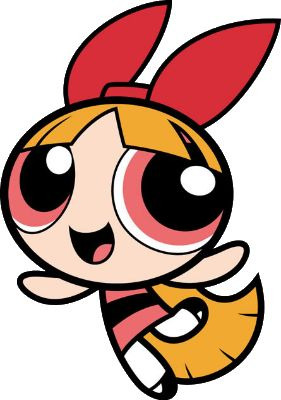
Sugar. Spice. Everything Nice. Chemical X. These are the things that created a trio of super-powered kindergartners, the leader wearing a large red bow over her long red locks and has a pink dress (and improbably large pink-colored eyes). These girls had to save their city from monsters and evil villains while attending Kindergarten and making time for their playroom. Blossom was Miss Perfect personified: cute, long pretty hair, perfect grades, ladylike behavior, intellectual, emotionally mature (she acted more 10 years old rather than her actual age of being born in a 5 year old’s body); but being Miss Perfect can make you blind to the resentment of others (she is rather bossy) and being liked and holding that as the standard could let you get run over. It’s fortunate that Blossom is learning how to advocate for herself and break the rules to save the day (like beating up evil senior citizens) now rather than at 14, 17, 24, 32.....
Power Ranking: 11.
Renee Bennett

Renee Bennett (as played by Amy Schumer) is insecure about living in a world that seems to stop for women fitting a narrow standard of beauty, which doesn’t concern her as far as she’s concerned. Now Renee wears pink a few times in the film, highlighting her femininity and desire to be universally beautiful. She happens to make a wish to be beautiful during a rainstorm and the next day, she goes to Soul Cycle where she falls off a bike, hair gets caught in the bike and she hits her head and wakes up seeing a different person in the mirror.
Now she walks around the world as if she was confident in being one of the most beautiful women in the room, if not the world. Suddenly her clothes show more skin, they are more twee (the bright colors and pastels), she’s taking huge fashion risks, and participating in bikini contests. Of course every film high hits a low where the protagonist’s ego is swollen, her friends feel alienated and later she bonks her head and believes she is back in her old body and no one has seen how “hideous” she is. Later she finds the confidence to “come out” as she is (as far as others are concerned, she hasn’t changed her looks too much).
Power Ranking: 7.5
#GLOW Netflix#Mean Girls#The Plastics#Regina George#Cady Heron#Karen Smith#Gretchen Wieners#Pretty In Pink#Andie Walsh#Debbie Eagen#Ruth Wilder#Melanie Rosen#Jenny Chey#Grease#Pink Ladies#rizzo grease#Betty Rizzo#Frenchie Grease#Marty Grease#Jan Grease#Tiana#Tiana Morales#Napoleon Dynamite#Deb Bradshaw#Family Guy#Meg Griffin#costume analysis#Little Movie#Jordan Sanders#As Told By Ginger
1 note
·
View note